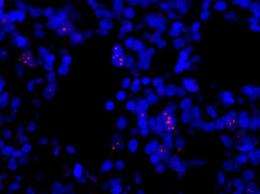Two genes linked to why telomeres stretch in cancer cells

Scientists at Johns Hopkins have provided more clues to one of the least understood phenomena in some cancers: why the "ends caps" of cellular DNA, called telomeres, lengthen instead of shorten.
In a study published online June 30 in Science Express, the Johns Hopkins researchers say they have identified two genes that, when defective, may cause these telomere elongations.
Telomeres contain repeated sequences of DNA that, in normal cells, shorten each time a cell divides. Without telomeres, the cell division-related shortening could snip off a cell's genes and disrupt key cell functions. Most cancer cells, naturally prone to divide rapidly, use high amounts of an enzyme called telomerase to keep their telomeres intact. Yet, some cancer cells are known to maintain their telomere length without help from telomerase.
With no increased production of telomerase, scientists were left to wonder how cancer cells managed to maintain their telomeres, a phenomenon known as "alternative lengthening of telomeres."
"Finding the genes responsible for alternative lengthening of telomeres is the first step in understanding this process and provides opportunities to develop new drug therapies," says Nickolas Papadopoulos, Ph.D., associate professor at the Johns Hopkins Kimmel Cancer Center and director of translational genetics at Johns Hopkins' Ludwig Center.
The first clues to the genes linked to the process came from a study led by Papadopoulos that mapped the genome of pancreatic neuroendocrine tumors, published in the Jan. 20 issue of Science Express. The most prevalent gene alterations in those tumors occurred in genes that include ATRX and DAXX. Proteins made by these genes interact with specific portions of DNA to alter how its chemical letters are read. ATRX and DAXX had also been linked to similar functions in the telomere region, says Alan Meeker, Ph.D., assistant professor of pathology, urology and oncology at Johns Hopkins.
Following a hunch, Meeker and his colleagues took a closer look at the two genes and their specific role in telomere lengthening. With tissue samples from 41 patients with pancreatic neuroendocrine tumors collected during the genome mapping project, the scientists found characteristic signatures of alternative telomere lengthening in 25 of them. Fluorescent dyes targeted specifically to telomeres showed "huge aggregates of telomere DNA" in the 25 samples, with each fluorescent spot holding about 100 times more telomere DNA than normal cells, according to Meeker.
Nineteen of the 25 samples that glowed positive for alternative telomere lengthening had either ATRX or DAXX mutations. Six of those
25 samples did not contain ATRX or DAXX mutations, but the tumor cells showed no expression of these two genes. The remaining 16 samples with no alternative lengthening lacked mutations and had adequate ATRX and DAXX expression.
"We saw a 100 percent correlation between abnormalities in ATRX and DAXX and alternative lengthening of telomeres," says Meeker.
Among 439 other samples of tumors tested by Meeker, Papadopoulos and colleagues, ATRX mutations were found in several brain cancer types, including pediatric and adult glioblastoma samples provided by Hai Yan, M.D., Ph.D., and Darell Bigner, M.D., Ph.D., of Duke University.
Meeker and colleagues tested the telomeres status in glioblastoma samples with tissue available for the assay. All eight glioblastoma tissue samples with ATRX mutations showed the characteristic bright glow of their telomeres, indicative of alternative lengthening, and lack of ATRX expression.
Although the Johns Hopkins team does not yet have an explanation for how the genes do their lengthening work in cancer, Meeker speculates that the mutations alter the way that telomere DNA is packaged, exposing those areas to instability.
Papadopoulos' genome mapping studies showed that patients with pancreatic neuroendocrine tumors containing ATRX/DAXX mutations had better survival than those without the mutations.
"If the correlation holds up, we could use alternative lengthening of telomeres and ATRX/DAXX mutations as a method of determining a patient's prognosis in addition to developing treatments that target these genes," says Meeker.














